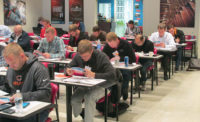pme recently attended the ribbon-cutting ceremony for the reopening of the Bell & Gossett Little Red Schoolhouse training center in Morton Grove, Illinois. BNP Media Plumbing Group’s Nicole Krawcke sat down with Mike Licastro, Xylemn’s training and education manager, commercial building services and HVAC, to chat about the renovation of the iconic industry training facility and what it now offers its customers.
pme: What triggered the renovation of the Little Red Schoolhouse?
ML: The Little Red Schoolhouse was built in 1954, and along the way, we were adding to the displays with the latest technology. We had this point in time where we had a large explosion of new technology coming out, so we felt we wouldn’t be doing justice by trying to just squeeze it in there. We decided let’s step back, let’s evaluate the schoolhouse as a whole and how can we make the experience better? That’s what led to this full renovation.
If we’re going to be promoting proper design and energy efficiency, then why isn’t our mechanical room for our space using those technologies? That’s what led us to the second phase, which was the complete renovation of our HVAC and plumbing systems internally. In my opinion, and the opinion of many people I’ve spoken to, the hands-on approach is, by far, No. 1. It’s really irreplaceable to be able to actually physically see a product, touch a product and watch it operate. We felt we needed to make sure this environment continued to provide that approach.
pme: How did you decide which products and technologies to include in the schoolhouse?
ML: We looked and we saw where the industry was going, and we wanted to make sure we put products in the schoolhouse that enhanced and complemented the efforts of what the industry was doing. So we looked at the plumbing products booster systems, for example. We see more buildings getting larger. And the water pressure supplied by the new suppliers is never high enough to be able to get water properly up to the highest point in the building. So with variable-speed control technology, we felt it was imperative we had a pressure booster system that we could show the students.
The other thing is we have a responsibility to safety. The big buzz in plumbing is Legionnaire’s disease. One of the ways to mitigate legionella is the recirculation system designed properly at the right temperature to ensure there’s no stagnant water in the system. We felt it was important to show in our training how to properly design those settings, and then what products are available to help in doing it right.
pme: How many students/customers come through the Little Red Schoolhouse each year?
ML: We have documented about 65,000 customers physically coming through the schoolhouse since its opening in 1954. Annually, we see somewhere between 800 to 1,000 students, but we also do training for our own employees and go out remotely. Not everybody can come to the Little Red Schoolhouse, so many of our reps will orchestrate and organize trainings in their areas. Myself and other instructors will go out and do those remotely. If you add in all of those trainings, we end up training about 1,200 to 1,400 people per year.
pme: What is the biggest shift the company has made in the last year to best serve customers?
ML: Bell & Gossett continues to lead the industry in providing smart solutions for modern-day challenges facing its customers through both product innovation and deep technological expertise. Bell & Gossett’s current portfolio of products are designed to optimize performance across a variety of applications. In new or retrofit commercial building HVAC systems, total system design is the key to maximizing efficiency. By combining Bell & Gossett’s expansive portfolio of pumps with advanced variable-speed drives and ECM motors, hydronic systems can achieve greater efficiencies than ever before, saving thousands each year in energy costs.
pme: What’s next for Bell & Gossett?
ML: Industry and regulatory changes will continue to influence how Bell & Gossett goes about designing and constructing buildings and systems. For example, the decarbonization trend that started in California and New York to reduce emissions that produce climate pollution de-emphasizes fossil fuels and promotes expansion of electricification technologies. That affects gas-fired boilers in HVAC systems in large commercial buildings. There is a ripple effect that will affect all aspects of building and system design. Water-based systems still are well-positioned to serve the market effectively into the future.




